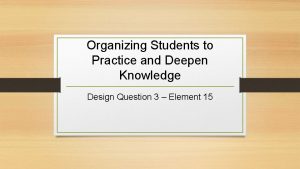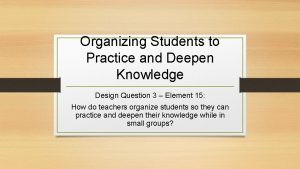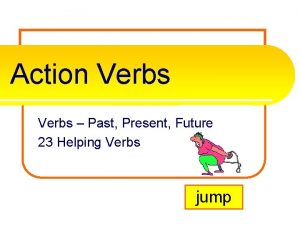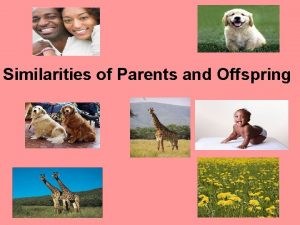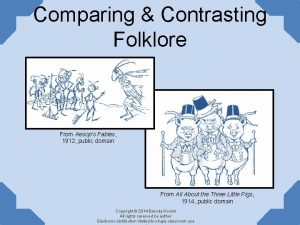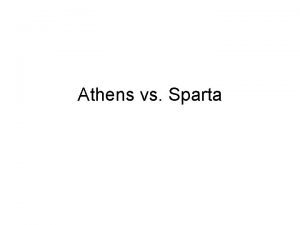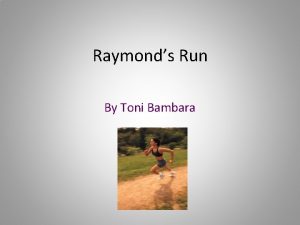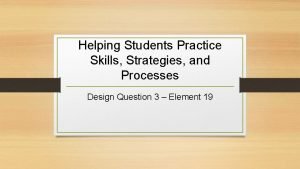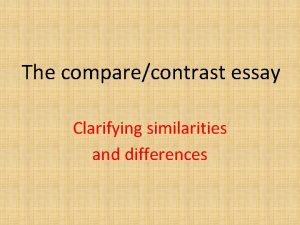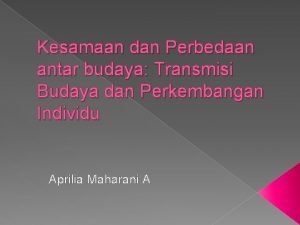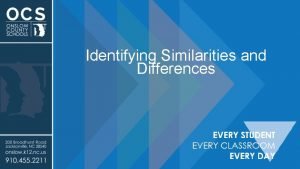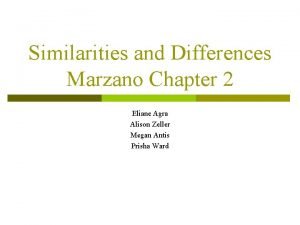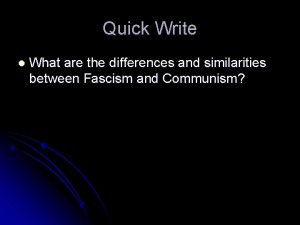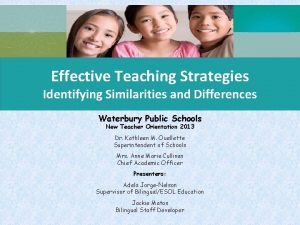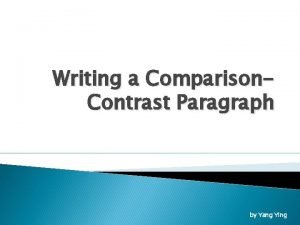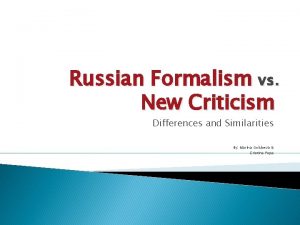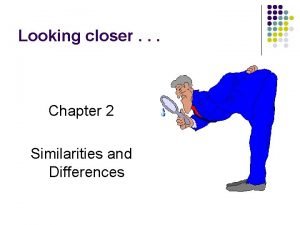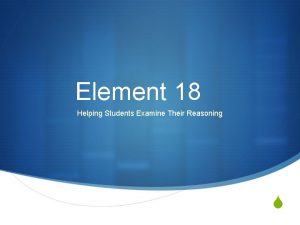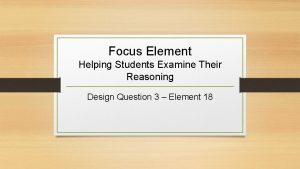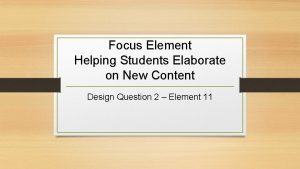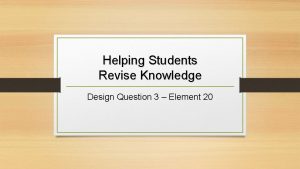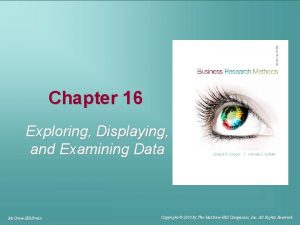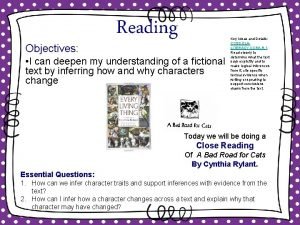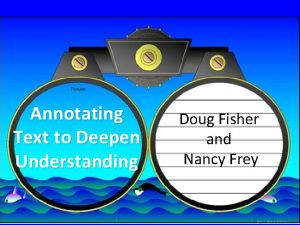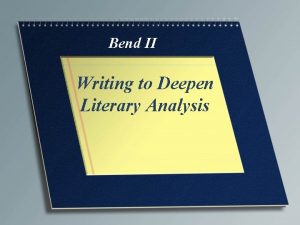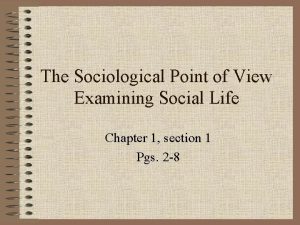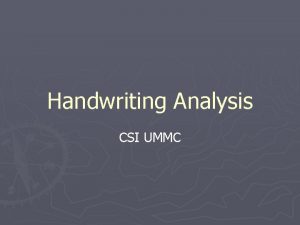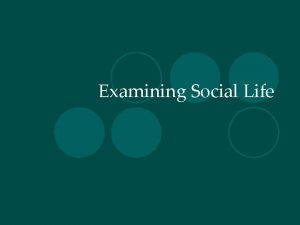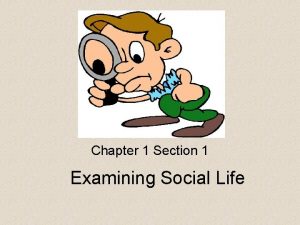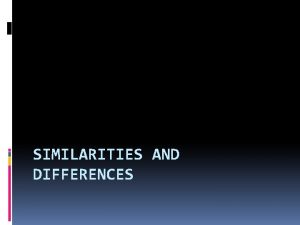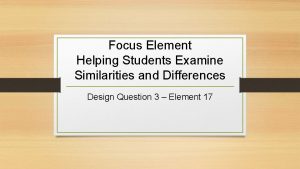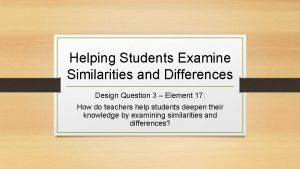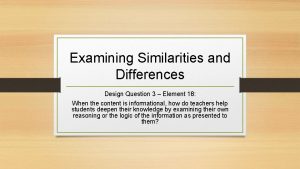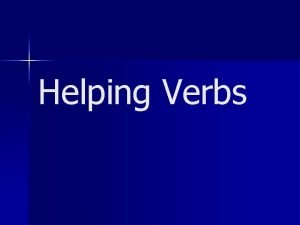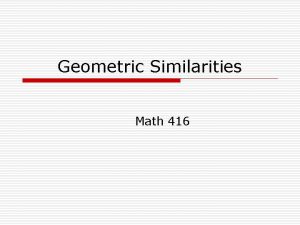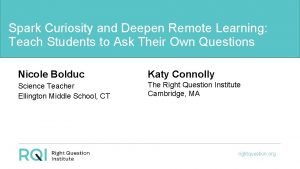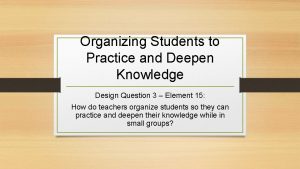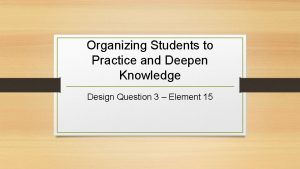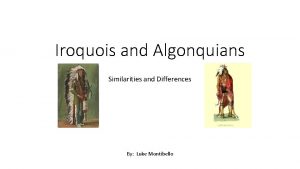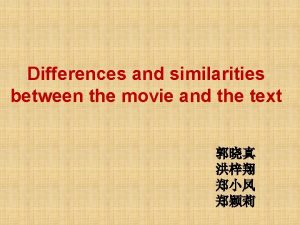Examining Similarities and Differences Helping Students to Deepen







































- Slides: 39

Examining Similarities and Differences Helping Students to Deepen Their Understanding of Critical Content S

Scor e Description 4 In addition to 3. 0 elements, I can: • Adapt the learning experience to either scaffold or extend the learning experiences of my students based on their specific needs. 3 I can: • Design and implement learning experiences utilizing a variety of strategies for my students to examine similarities and differences. • Monitor student responses for the desired effect and determine next steps for supporting students with this learning experience. 2 I know: • The definitions for: compare, classify, metaphor, analogy • The steps needed to design lessons using similarities and differences. • The desired effects for this element. • What questions I need to consider when designing learning experiences at this depth of learning. • Six different strategies to use when examining similarities and differences. 1 With guidance and support, I can complete some of the 2. 0 and 3. 0 elements.

Four Processes of Examining Similarities and Differences S Comparing S Classifying S Creating metaphors S Creating analogies Ultimate Goal: identifying relationships between objects, ideas, concepts, events, places and people.

Mastery of this element… S Will enable your students to constantly add new content knowledge to previously learned material in their longterm memory, creating new and deeper knowledge.

Collaborate with Colleagues to Create Common Definitions: S Comparing-is a way to identify similarities and differences between or among things S Classifying-is a way to put things that are alike into categories based on their characteristics S A metaphor-is a characteristic (attribute) shared by two objects (topics) that seem to be quite different. S An analogy- is a comparison of two similar objects (things, ideas, people)

Directly Teach/Model S Be prepared to think aloud and model for your students how and what you are thinking as you examine similarities and differences. S Intentionally slow down your own thinking in order to articulate connections, background knowledge and problem solving you are drawing upon

Using Mental Tools S Unless you and your students understand can identify the important characteristics or attributes of what you are comparing, you’ll be wasting precious time. S Regularly use summarizing and generalizing to conclude any lesson where students examined similarities and differences.

Record and Represent Knowledge Regulary S Sentence stems-skeletons that contain a basic structure creating the parameters of a thinking task combined with blanks for students to fill in the appropriate answers. S They can be used for comparing tasks as well as creating analogies and metaphors S Graphic Organizers-This tool helps students organize the information for the actual comparison. S They are a means to an end, not the end themselves.

Behaviors Associated with Effective Implementation S Identify critical content for examination S Identify similarities and differences between critical concepts S Provide opportunities for linguistic and non-linguistic representation of similarities and differences S Ask students to summarize what they have learned S Guide students to draw conclusions from the examination of the similarities and differences S Facilitate use of digital resources to find credible and relevant information.

Monitoring for Desired Effects S Ask yourself: S Did my students deepen their understanding of the content by completing this work? S How do I find out? S Was the desired effect of the strategy achieved? S Students will be able to describe how various aspects of the content are similar and different and then be able to state any new information or generalizations they have learned as a result of the activity.

Ways to Monitor… S Students can: S Create analogies and/or metaphors that reflect their depth of understanding S Demonstrate that the comparison and classification activities reflect their depth of understanding S Accurately identify similarities and differences and how their knowledge has been extended as a result of the activity S Accurately summarize their findings S Present evidence to support their explanation S Generalize patterns or draw conclusions and apply them to new examples and ideas. S Navigate digital resources to find credible and relevant information to support the similarities and differences.

Monitor and Reflect S The more teachers monitor their students and reflect on how they are progressing in the learning process, the better equipped they will be to adjust their instruction to meet student needs. The difference between a good teacher and a great teacher is the relentless inspection of student work. -Rick Du. Four


This should be ou r focus… We tend to monitor for compliance and engagement.

S What are the critical parts of this definition? S Teacher act S Checking evidence S Desired student learning of critical content S During instruction

Facilitation Grid for Monitoring Take your learning targets or criteria for success and put them on the facilitation grid. S Use some sort of collection tool as you monitor student progress toward the understanding of critical content. S A facilitation grid is one method. S Write the student names down the left side. S Write the learning targets or criteria you are looking for as you monitor student learning across the top. S In this case it is what ever you expect to see the students writing, doing or saying as you walk around. S As you walk around and monitor student work, check off who has it and who does not.

This is where we want to live. This is where we tend to spend most of our time currently.



Monitoring During Instruction S Teacher Observation: S Walk and listen to student conversations around critical content S Watch and listen to demonstrations, oral presentations, etc. of S S S critical content Spot check student work to determine progress Ask probing questions to redirect or elevate thinking Review student class work Observe students as they work with manipulatives Observe students as they respond by pointing to correct answers or represent the correct answer through body movement

Teacher Self-Reflections S How can I incorporate some aspect of this element into my instruction? S How can I engage students in activities that help them record and represent their knowledge and understanding of important content using a variety of models? S How can I monitor the extent to which recording and representing knowledge enhances student understanding?

Scaffold/Support-Adaptations S Use pictures, graphics, and diagrams S Provide sentence stems S Develop guiding/probing questions S Tell stories to illustrate examples S Regroup students to provide additional support S Show work samples or point out exemplars S Review reasoning behind responses before asking students to respond S Provide a brief overview of critical content S Post anchor charts, helpful lists, diagrams or techniques

Extension Adaptations S Students answer questions that stretch them just beyond the standard to deepen and extend their thinking. S Students categorize important terms and make generalizations based on those categories. S Students identify how each chunk of information or each activity relates to the learning targets. S Students identify similarities and differences between learning targets, and groups’ conclusions or solution methods. S Students create their own graphic organizer to share with the class. S Students identify strategies and techniques that were particularly useful to their knowledge gain. S Students create picture, graphics, and diagrams of previously learned skills or procedures to share with the class.

Connecting PLC Work - Monitoring S You are the content experts, so use each other’s experience and knowledge during your PLC time to: S Prioritize and problem solve around the most critical content students must learn. S Determine what mastery of the target/standard(s) looks like. S Analyze data in order to share successful strategies and meet the needs of all students. S Brainstorm scaffold/supports could be used to support student learning. S brainstorm extensions that could be used in the learning moment to extend student learning.

Teacher Requirements… S Ask probing questions-DON’T Rescue them and provide the answer S Assess the quality of group discussions and student work S Observe students closely during the lesson S Find ways to hear the thinking of each student-do not accept group responses as an effective means monitoring individuals S Give students opportunities to revise their thinking after a lesson or discussion and to also explain how they gained better understanding.

Scaffolding S Enlist help from students from their peers, instructional aides or other paraprofessionals S Provide an easier reading level that contains the same content S Break the content into smaller chunks S Give students organizers to clarify and guide their thinking through the task one step at a time.

Teacher Self-Reflection S How can you begin to incorporate some aspect of this strategy in your instruction? S What are some ways you can encourage your students to become more independent in their examination of similarities and differences? S What are some ways you can check to see if most students are accurately identifying similarities and differences? S What are ways you can adapt and create new techniques for identifying similarities and differences address unique student needs and situations? S What are you learning about your students as you adapt and create new techniques?

Sentence Stems, Summarizers and Constructed Responses S Used to scaffold student thinking guiding to the ultimate goal of creating summary statements. S Each one is slightly more challenging than the previous. S As they become skilled at sentence stems, move them on to summarizers and then on to constructed responses.

Sentence Stems Type of Sentence Stem Example General Stem: comparing larger groups Reptiles are like amphibians because ______________________. Reptiles are different from amphibians because ______________________. Specific Stem: Comparing two specific items A frog and toad are alike because ________ and ___________. They are different because ___________ and __________. Open-ended stem that requires a certain number of responses ________ and _______ are similar because they both ______________ and _______ are different because _________ is _________, but __________ is ______________.

City #1 Tucson, AZ Summary Box Tucson, Arizona, a south- west desert community, and Honolulu, Hawaii, a tropical island paradise are desirable, multicultural locations in which to live and vacation. Differences City #2 Honolulu, Hawaii Summarize r Similarities Differences Desert plants and animals Cities in the United States Tropical plants and animals Mexican and Native American cultures Favorite vacation spots for people all over the world Japanese, Hawaiian, and Asian cultures Landlocked Multicultural Surrounded by water Gets little rain and has very low humidity. Residents and visitors can wear shorts and sandals most of the year Tropical rain forest with very high humidity

Aspect of the city to be compared City #1 Tucson, AZ City #2 Honolulu, HI What is most important about the aspect? Constructed Response Scaffold Compare the two aspects Location Unites States Mainland United States a Hawaiian Islands They are both in the US although Honolulu is on an island (Oahu) and Arizona is on the mainland. Population 520, 116 Metropolitan Area Pop 980, 236 Population 390, 738 Metropolitan Area Pop-953, 207 The cities are similar in the population sizes of their metropolitan areas although Honolulu is a smaller city in terms of population within actual city limits. Cultures Mexican American Native American Caucasian Asian, Hawaiian, and Caucasian The cities are similar in that they both are home to a variety of cultures. Climate Hot and dry in the summer, moderate and warm in the winter Warm and humid in some areas, but ocean breezes keep the weather moderate. They climates are similar in some ways (warmer temperatures). Economy Tourism and health care major sources of economic growth Tourism, health care, and higher education are major sources of revenue in the city. The cities are similar in that they depend on tourism for their economic strength as well as major hospitals, health care providers and universities.

Organization al Structure Planning Area Constructed Response Topic Sentence Although Tucson and Honolulu have very different geographic locations, they are far more alike than different. Location Tucson is situated on the mainland in a landlocked area with hardly any natural bodies of water, while Honolulu is on an island surrounded by the Pacific Ocean. However, in all of the following aspects, the cities are very similar. Population Tucson and Honolulu are cities with about the same metropolitan population. Cultures They are both very multicultural with residents from varying backgrounds and homelands. Climate Even with its hot and dry summers, Tucson is similar to Honolulu in that it attracts many visitors from around the world to enjoy moderate temperatures and sunshine during the winter months. Economy Tourism, health care, and higher education are major contributors to the economies of both cities. Conclusion Sentence Despite their different locations and geographic features, Tucson and Honolulu are both attractive cities in which to live, work, and vacation.

Comparing Using Graphic Organizers S Venn Diagram S Double Bubble S Comparison Matrix S Modified T-Chart S Each get increasingly more difficult

Four Mental Steps 1. Choosing exactly what will be compared 1. Identifying the critical attributes or most important characteristics to be compared 1. Determining whether the attributes or characteristics are alike or different 1. Summarizing or drawing conclusions (generalizing) about the overall findings.

Classifying Using Sorting, Matching, and Categorizing Type of Classifying Student Outcome Sorting When presented with specific categories by the teacher students can sort content into these categories based on their similar attributes. Matching When presented with various types of content, students can match two or more things based either on their sameness or equivalence. This equivalence could exist in the form of a definition and picture that go together, a picture and description that match; various mathematical expressions that, when solved, express identical values; or the matching of uppercase and lowercase letters that express different forms of the same letter. Categorizing When presented with a list of elements, students can organize them into two or more categories, explain the critical attributes of the categories, they have selected, and explain and defend why each element belongs in a specific category.

Classifying Using Graphic Organizers Step Example Select the set of items that need to be classified. Set of items is all the vocabulary words listed on the board for today’s story Determine the major superordinate categories represented in the set of items. List of words can be classified in several different ways. It contains verbs, nouns, adjectives, and conjunctions. Name the superordinate category All of these categories belong to the to which the concept belongs and superordinate category known as parts of explain why it belongs in that speech. category. Identify any subordinate categories for the concept and explain why they belong in the category. The list of nouns has subordinate categories: persons, places, or things. The nouns include Little Red Riding Hood, grandmother, basket, forest, and cape. Items are either persons, places or things. Therefore, they belong in this noun category

Comparing by Creating Metaphors and Similes S Students have been taught to identify metaphors and similes and learned how to create them in their own descriptive writing. S However, this is not the intent of this technique. S This strategy will help you show students how to deepen their understanding of critical content through the creation of their own original simile or metaphor. S This takes them to a new level of analysis and insight on the content.

Teach and Model S Explicitly Teach (see lesson plan to teach similes in module) S Use sentence stems S Think out loud as you model Sentence Stem Example ________ is really a ________. A conjunction is really a bridge in my writing. Think of a _______ as a __________. Think of a conjunction as a bridge. ________ reminds me of A conjunction reminds me of a _______ because bridge because they both connect ___________. important things.

Are you looking for some more ideas? S Yo u can also refer to the Esse ntials Rigor for Serie Exam sining Simil aritie s and Differ ence s
 Organizing students to practice and deepen knowledge
Organizing students to practice and deepen knowledge Organizing students to practice and deepen knowledge
Organizing students to practice and deepen knowledge 23 helping verbs song
23 helping verbs song Similarities between parents and offspring
Similarities between parents and offspring What is the difference between ncbts and ppst
What is the difference between ncbts and ppst Similarities and differences of ants and grasshopper
Similarities and differences of ants and grasshopper Compare sparta and athens
Compare sparta and athens Gretchen raymond
Gretchen raymond What is wid, wad and gad
What is wid, wad and gad Helping students practice skills strategies and processes
Helping students practice skills strategies and processes Compare definition
Compare definition Cross cultural differences and similarities
Cross cultural differences and similarities Identifying similarities and differences
Identifying similarities and differences Marzano similarities and differences
Marzano similarities and differences Similarities and differences of fascism
Similarities and differences of fascism Identifying similarities and differences examples
Identifying similarities and differences examples Find similarities and differences
Find similarities and differences Research4life password
Research4life password How to write a contrast paragraph
How to write a contrast paragraph New criticism and formalism differences
New criticism and formalism differences Similarities and differences table
Similarities and differences table Identifying similarities and differences
Identifying similarities and differences Similarities and differences
Similarities and differences Helping students examine their reasoning marzano
Helping students examine their reasoning marzano Helping students examine their reasoning
Helping students examine their reasoning Helping students elaborate on new content
Helping students elaborate on new content Helping students elaborate on new content
Helping students elaborate on new content Learning target
Learning target Helping students revise knowledge
Helping students revise knowledge Data preparing exploring examining and displaying
Data preparing exploring examining and displaying Deepen my understanding
Deepen my understanding Annotation slows down the reader to deepen understanding
Annotation slows down the reader to deepen understanding Annotation slows down the reader to deepen understanding
Annotation slows down the reader to deepen understanding The stolen party analysis
The stolen party analysis The comparative study of past and present cultures
The comparative study of past and present cultures Two people can have identical handwriting.
Two people can have identical handwriting. Sociology relation with other social sciences
Sociology relation with other social sciences Examining social life practice
Examining social life practice Acquiring spiritual knowledge part 4
Acquiring spiritual knowledge part 4 What conclusions can you make from examining the geochart?
What conclusions can you make from examining the geochart?
